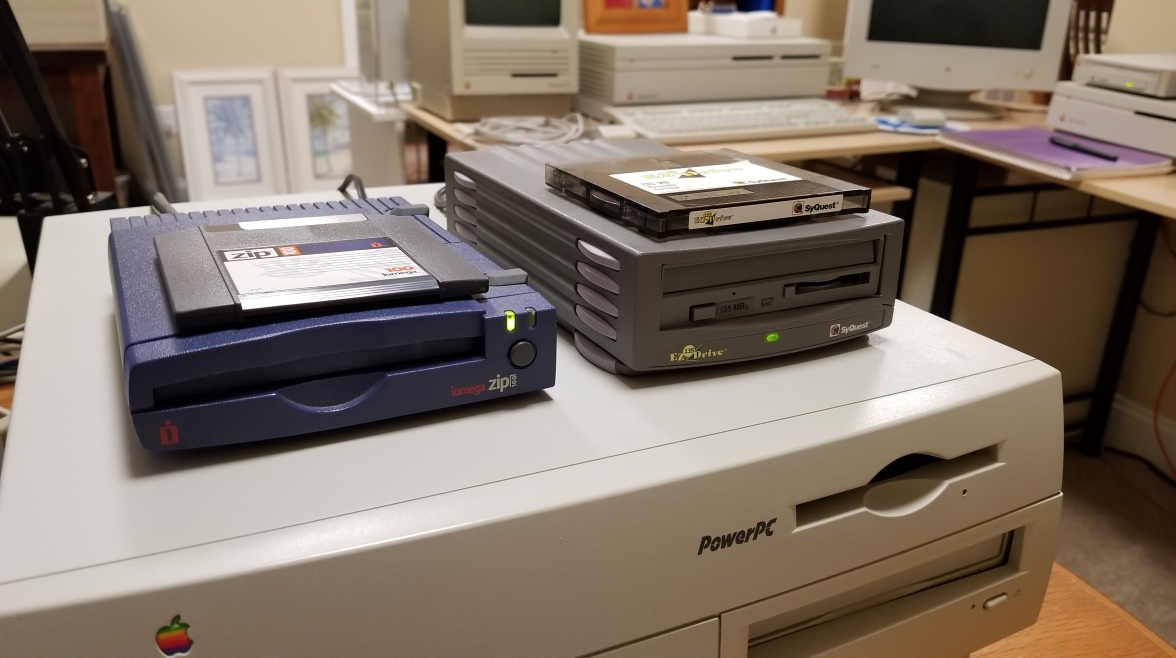In the last two posts on the topic of the SyQuest EZ-135 “super floppy”, we looked more closely into the product, compared it to the Zip-100, installed the software and hardware and got it fully functioning under Mac OS 8.6 on the Happy Mac Lab’s Power Macintosh 7500/366.
Now, with our SyQuest EZ-135 installed, set up and running successfully, the next questions are clearly “how fast is?” and “how fast is it relative to its Iomega Zip-100 competitor?”. This post delves into that question and provides answers.
The EZ-135 specs seem to have it running about 70% faster than a Zip-100, so it was time to test this out. As a quick refresher from the original post in this series, here is what the relevant specs say:
Iomega Zip-100:
- Average Seek Time: 30ms
- Sustained Transfer Rate: up to 1.4 MB/s
SyQuest EZ-135:
- Average Seek Time: 13.5ms
- Sustained Transfer Rate: up to 2.4 MB/s
As it happens, I have the good fortune to have both the EZ-135 and a Zip-100 in the Happy Macs lab, both external SCSI interfaced units. In turn therefore I connected each to the same Mac, my Power Mac 7500/366, and tested their performance at the same real world tasks.

The Test
The real world test tasks chosen were a small simulation of a backup and a restore: copying roughly 6.3 MB of large files (400KB to 500KB each) onto the cartridge from the HD, and then copying them back onto the HD from the cartridge. As a bonus, and since I had one handy, I performed this same “benchmark” using an Iomega Jaz 1GB as well.
The Results [drum roll please…]
Here are the results (smaller results are better):

These results show that in the real world work of backing up and restoring files, the EZ-135 is faster than the Zip-100, but not by quite as much as the above specifications might lead you to expect. The EZ-135 was 33.9% faster to copy from the HDD to the cartridge, and 41.5% faster to copy from the cartridge to the HDD. Of course, the Jaz drive outpaced both of them by a healthy margin, which comes as no surprise.
SyQuest EZ-135, Conclusions and Wrap Up
In head-to-head performance testing, the EZ-135 beat the Zip-100 by at least 33%, and up to as much as 41%, at the primary task which framed their all too brief time in the sun – backup and restore. Setting these results aside for just a moment and looking at the rest of the commercial offer, the two platforms were remarkably similar: both featured solid hardware platforms, good to excellent software support and very similar usage paradigms. So, with all other things being more or less equal, and with its higher performance, why didn’t the technically superior EZ-135 dominate the market? What happened?
In the end, it may be as simple as time-to-market. The Zip-100 had a six month market lead on the EZ-135, and was firmly established before the EZ-135 debuted. In addition, it was backed by aggressive marketing, widespread bundling with manufacturer offerings (Apple offered the Zip-100 as an option on several models of Macintosh, as did many PC vendors) and a slightly lower price point. Thinking back, I purchased a Zip-100 almost as soon as they came out, and I remember being dimly aware that there was now a competitor when I decided to purchase a second one. However, cartridge compatibility was important at that point, and my second “super floppy” (and all subsequent ones until this series of blog posts) was another Zip-100.
That may be it in the final analysis… time to market and cartridge compatibility. We will never know of course, and so the EZ-135 remains as a fascinating “what if” product, but one that I have been pleased to bring back to life in the pages of this blog, if only for a brief moment.
On a personal note, as a result of this series of posts, I now have two of these excellent devices in the lab, and I plan to keep them in service doing the type of work they shine at these days… mass file transfer to vintage Macintosh computers that I am performing initial software loads on. Of course, the Zip family of devices is well represented throughout the Happy Macs lab and is not going away, and so both the EZ-135 and the Zip-100/250 will coexist and each be used as the application of the moment dictates.
This might seem like the end of the road for this series of posts but we are not quite there yet. There will be one more post… After all the work I have done recently on System 6, I couldn’t resist testing the EZ-135’s support on System 6 Macs. This is particularly useful to me just now as I have a newly acquired Macintosh IIfx that I am about to load up with System 6 and a set of compatible applications. Stay tuned therefore for one last edition of the “EZ-135 story”, telling the tale of System 6 and the EZ-135. Coming soon to a blog near you! Until then…
